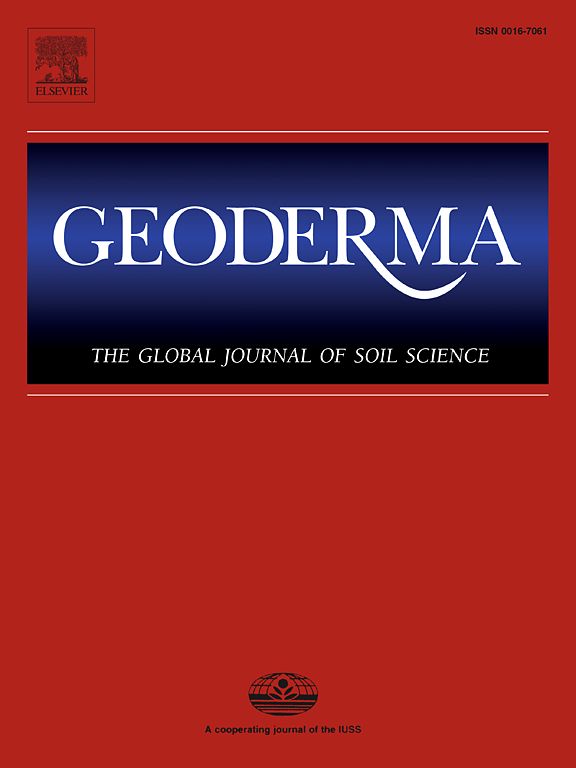在冻融循环和不同砾石含量条件下评估中国东北季节性冰冻地区含砾森林土壤的压缩特性
IF 6.6
1区 农林科学
Q1 SOIL SCIENCE
引用次数: 0
摘要
由于气候变化,高纬度永久冻土和季节性冰冻地区的人类活动和自然扰动逐渐增加,引起了学者们更多的关注。然而,研究主要集中在这些地区的土壤生物和化学方面,对其力学性能,尤其是压缩性能的探索十分有限。本研究旨在评估砾石含量和冻融循环(F-T)对中国东北季节性冰冻地区粗粒层状森林土壤压缩性能的影响,目的是预测土壤在重型机械载荷作用下的压缩变化。具体而言,对 252 个扰动土壤样本(包括 AB 和 Bhs 两个土层;六个砾石层)进行了单轴约束压缩试验(UCCT):AB 和 Bhs 两种土层;六种砾石含量;七个 F-T 循环),测量了三个特征压缩系数--预压缩应力 (σpc)、压缩指数 (Cc) 和膨胀指数 (Cs)。此外,还使用扫描电子显微镜(SEM)分析了粗粒含砾土壤的中观结构演变。在不同砾石含量的 15F-T 循环后,测量了样品的体积变化。结果表明,砾石含量和 F-T 循环对 σpc 有非线性影响。砾石含量低于 50% 会对 σpc 产生积极影响,而含量高于 50% 则会增加土壤孔隙含量,从而降低 σpc。Cc 和 Cs 与砾石含量呈近似负相关,随着 F-T 循环次数的增加,Cc 和 Cs 最初会增加,随后会减少。此外,AB 层的σpc 和 Cc 要高于 Bhs 层,这可能是由于粘土和有机碳含量的不同。值得注意的是,观察到的趋势与之前对其他土壤类型(如农田和水田)的研究不同。这项研究填补了了解季节性冰冻地区层状含砾森林土壤压缩特性的空白,为评估季节性冰冻地区和永久冻土地区的土壤压缩性以及了解机械车辆与土壤之间的相互作用提供了有价值的见解。它还为构建层状含砾森林土壤压缩模型奠定了理论基础并提供了数据支持。本文章由计算机程序翻译,如有差异,请以英文原文为准。
Assessing the compression properties of Gravel-bearing forest soil in northeast China’s seasonally frozen regions under Freeze-thaw cycles and varying gravel content
Due to climate change, human activities and natural disturbances in high-latitude permafrost and seasonally frozen areas are gradually increasing, attracting more attention from scholars. However, research primarily focuses on soil biology and chemistry in these regions, with limited exploration of their mechanical properties, especially compression properties. This study aims to evaluate the effects of gravel content and freeze–thaw (F-T) cycles on the compression properties of coarse-grained layered forest soil from northeast China’s seasonally frozen regions, with the goal of predicting the soil’s compressive changes under heavy mechanical loads. Specifically, using uniaxial confined compression tests (UCCT) on 252 disturbed soil samples (including two soil layers: AB and Bhs; six gravel contents; and seven F-T cycles), three characteristic compression coefficients—precompression stress (σpc), compression index (Cc), and swelling index (Cs)—were measured. Additionally, scanning electron microscopy (SEM) was used to analyze the mesostructure evolution of coarse-grained gravel-bearing soil. Volume changes of samples were measured after 15F-T cycles with varying gravel contents. Results indicate non-linear effects of gravel content and F-T cycles on σpc. Gravel content below 50% positively influences σpc, while content above 50% increases soil pore content, decreasing σpc. Cc and Cs exhibit an approximately negative correlation with gravel content and initially increase followed by a decrease with more F-T cycles. Moreover, the σpc and Cc of the AB layer are higher than those in the Bhs layer, likely due to differences in clay and organic carbon contents. Notably, the observed trends differ from previous studies on other soil types such as farmland and paddy fields. This study fills a gap in understanding the compression characteristics of layered gravel-bearing forest soil in seasonally frozen regions, providing valuable insights for evaluating soil compression in both seasonally frozen and permafrost regions, and understanding mechanical vehicle-soil interactions. It also lays the theoretical groundwork and provides data support for constructing compression models of layered gravel-bearing forest soil.
求助全文
通过发布文献求助,成功后即可免费获取论文全文。
去求助
来源期刊

Geoderma
农林科学-土壤科学
CiteScore
11.80
自引率
6.60%
发文量
597
审稿时长
58 days
期刊介绍:
Geoderma - the global journal of soil science - welcomes authors, readers and soil research from all parts of the world, encourages worldwide soil studies, and embraces all aspects of soil science and its associated pedagogy. The journal particularly welcomes interdisciplinary work focusing on dynamic soil processes and functions across space and time.
 求助内容:
求助内容: 应助结果提醒方式:
应助结果提醒方式:


